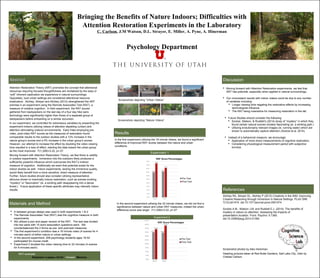
ChaliseCarlsonposter
- 1. Bringing the Benefits of Nature Indoors; Difficulties with Attention Restoration Experiments in the Laboratory C. Carlson, J.M Watson, D.L. Strayer, E. Miller, A. Pyne, A. Hinerman Psychology Department Student Photo Image upper middle Student Name Ab Attention Restoration Theory (ART) promotes the concept that attentional resources requiring focused thoughtfulness are revitalized by the easy or “soft” inherent captivation we experience in natural surroundings. Oppositely, loud urban settings are considered attentional resource eradicators. Atchley, Strayer and Atchley (2012) strengthened the ART premise in an experiment using the Remote Associates Test (RAT), a measure of creative cognition. In their experiment, the RAT scores gathered from backpackers on the last day of a four day hike sans technology were significantly higher than those of a separate group of backpackers before embarking on a similar excursion. In our experiment, we controlled for extraneous variables by presenting the experiment indoors utilizing videos of attention depleting (urban) and attention stimulating (nature) environments. Early trials employing pre- video, post-video RAT scores as the measures of restoration found comparable results to the outdoor studies with a 12% increase in the nature group’s scores and a 5% increase in the urban group’s scores. However, our attempt to increase the effect by doubling the video viewing time resulted in a loss of effect, slanting the data toward the urban group as the most improved. F(1,208)=3.22, p=.07. Moving forward with Attention Restoration Theory, we feel there is validity in outdoor experiments. Immersion into the outdoors likely produces a sufficiently powerful influence which overcomes the RAT’s indirect measure of cognition. Additionally we exert that potential exists for the indoor studies as well. Indoor experiments, lacking the immersive quality, would likely benefit from a more sensitive, direct measure of attention. Further, future studies should also consider utilizing representative stimulus shown to maximally induce restoration, such as scenes evoking “mystery” or “fascination” (ie. a winding path disappearing into a dense forest.) Future application of these specific attributes may intensify indoor results. A between groups design was used in both experiments 1 & 2. The Remote Associates Test (RAT) was the cognitive measure in both experiments. We utilized a pen and paper version of the RAT. The test was divided into two parts with 15 word association questions each. We counterbalanced the 2 forms as pre- and post-test measures. The first experiment’s condition was a 16 minute video (4 scenes for 4 minutes each) of either nature or urban settings. In the second experiment, 208 psychology students ages 18-52 participated for course credit. Experiment 2 doubled the video viewing time to 32 minutes (4 scenes for 8 minutes each). In the first experiment utilizing the 16 minute videos, we found a significant difference of improved RAT scores between the nature and urban conditions. AbstractAbstract Results Discussion References Moving forward with Attention Restoration experiments, we feel that ART has potential, especially when applied in natural surroundings. Our inconsistent results with indoor videos could be due to any number of variables including: Longer viewing time negating the restorative effects by increasing technological influence. The RAT being insensitive for measuring restoration in the lab. Atchley RA, Strayer DL, Atchley P (2012) Creativity in the Wild: Improving Creative Reasoning through Immersion in Natural Settings. PLoS ONE 7(12):e51474. doi:10.1371/journal.pone.0051474 Szolosi A.M., Watson J.M. and Ruddell E.J. (2014). The benefits of mystery in nature on attention: Assessing the impacts of presentation duration. Front. Psychol. 5:1360. doi:10.3389/fpsyg.2014.01360 Heading pictures taken at Red Butte Gardens, Salt Lake City, Utah by Chalise Carlson Experiment 1 Experiment 2 In the second experiment utilizing the 32 minute videos, we did not find a significance between nature and urban RAT measures, indeed the urban difference score was larger. F(1,208)=3.22, p=.07 Screenshot photos by Alex Hinerman Materials and Method RAT example: Elephant—Lapse—Vivid Answer: Memory Future Studies should consider the following: Szolosi, Watson, & Ruddell’s (2014) study of “mystery” in which they found certain natural scenes innately fascinating (ie. a winding path.) Utilizing evolutionarily relevant images (ie. running water) which are shown to automatically capture attention (Szolosi et al. 2014). Instead of a behavioral measure, we encourage: Application of more direct measurements of cognitive restoration. Considering physiological measurement paired with subjective surveys.